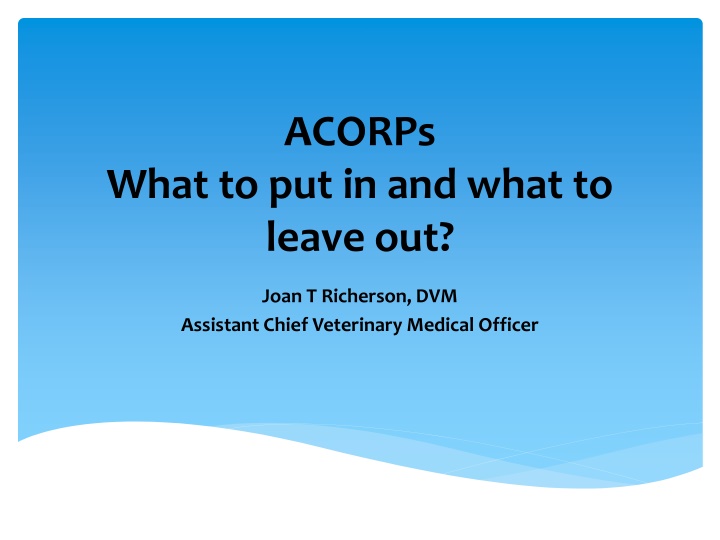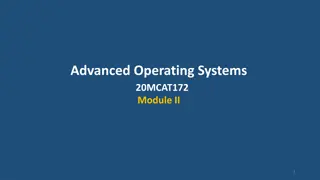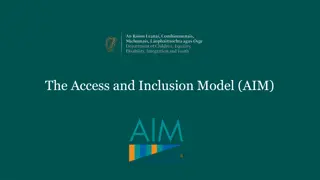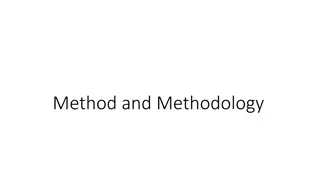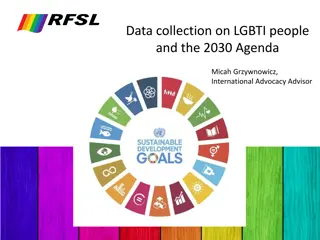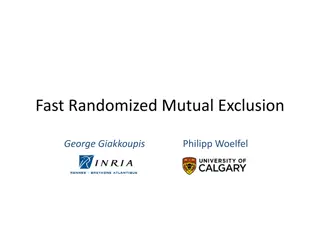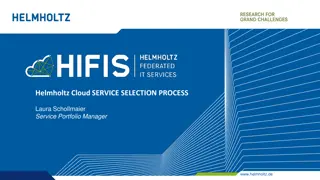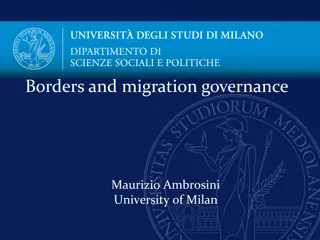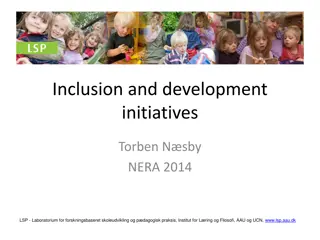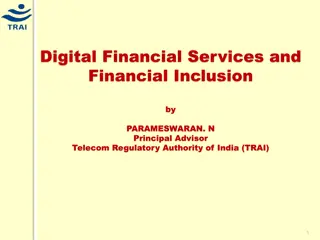Effective Inclusion and Exclusion Guidelines for ACORPs
Learn what to include and exclude in ACORPs from detailed guidelines by Joan T. Richerson, DVM, Assistant Chief Veterinary Medical Officer. Understand SOPs/MSDSs, radiation treatment details, occupational health and safety measures, and departures from standards specified in the Guide. Make informed decisions to ensure protocol compliance and safety.
Download Presentation

Please find below an Image/Link to download the presentation.
The content on the website is provided AS IS for your information and personal use only. It may not be sold, licensed, or shared on other websites without obtaining consent from the author.If you encounter any issues during the download, it is possible that the publisher has removed the file from their server.
You are allowed to download the files provided on this website for personal or commercial use, subject to the condition that they are used lawfully. All files are the property of their respective owners.
The content on the website is provided AS IS for your information and personal use only. It may not be sold, licensed, or shared on other websites without obtaining consent from the author.
E N D
Presentation Transcript
ACORPs What to put in and what to leave out? Joan T Richerson, DVM Assistant Chief Veterinary Medical Officer
SOPs/MSDSs Include in ACORP Do not include in ACORP SOPs that are specifically referenced in the ACORP Example: Endpoint criteria SOPs for routine animal husbandry SOPs for the handling of animals treated with hazardous agents SOPs for routine carcass disposal SOPs for unique experimental equipment Example: Cigarette Smoking Machine SOPs for animal adoption policy MSDSs for experimental agents unique to the study MSDSs for normal saline, isoflurane, ophthalmic ointment, etc.
Radiation A brief outline of the radiation treatment is often given in item C.2 (Experimental Design) but it lacks detail. Please complete an Appendix 6, which provides information that addresses: What is being performed? Where it is being performed? How it is being performed? Why it is being performed? Who is responsible?
OHSP Item G Occupational Health and Safety G.1 Enrollment in OHSP G.2 - Are there any non-routine OHSP measures that would potentially benefit, or are otherwise required for, personnel participating in or supporting this protocol? Most common and usually correct answer to item G.2 is No . However, G.2 should be answered Yes with an explanation when the research involves: Nonhuman primates Sheep, especially pregnant sheep Antibiotic resistant infectious agents Known teratogens
OHSP The information provided in item G and Appendix 3- subitem 10 (Protection of Animal Facility Staff from Hazardous Materials) should be congruent.
Appendix 9 Departures from "Must" and "Should" Standards in the Guide The vast majority of reported approved departures are actually specifically established Guide exceptions. Remember specifically established exceptions apply to deviations from must or should statements where certain exceptions are specifically described in the Guide and are considered acceptable when justified and approved by the IACUC. No reporting requirements.
Appendix 9 The two specifically established Guide exceptions commonly denoted as approved departures in Appendix 9 are: Single housing of animals with IACUC-reviewed scientific justification. Single housing exception may also be for social incompatibility or a veterinary-related concern. Use of non-pharmaceutical grade agents.
Specifically Established Exceptions (OLAW approved) Non-pharmaceutical grade chemicals or substances The use of non-pharmaceutical grade chemicals or substances should be described and justified in the animal use protocol and be approved by the IACUC (Wolff et al. 2003); for example the use of a non- pharmaceutical-grade chemical or substance may be necessary to meet the scientific goals of a project or when a veterinary or human pharmaceutical-grade product is unavailable. (pg. 31).
Specifically Established Exceptions (OLAW approved) Environmental Enrichment (Sounds) The Guide states Radios, alarms, and other sound generators should not be used in animal rooms, unless they are part of an approved protocol or enrichment program (pg. 50).
Specifically Established Exceptions (OLAW approved) Single Housing Social animals should be housed in stable pairs or groups of compatible individuals unless they must be housed alone for experimental reasons or because of social incompatibility (see also section on Behavioral and Social Management). (pg. 51) If necessary to house animals singly for example, when justified for experimental purposes, for provision of veterinary care, or for incompatible animals this arrangement should be for the shortest duration possible. (pg. 60)
Specifically Established Exceptions (OLAW approved) Aseptic surgery The Guide states Unless an exception is specifically justified as an essential component of the research protocol and approved by the IACUC, aseptic surgery should be conducted in dedicated facilities or spaces (pg. 116).
Specifically Established Exceptions (OLAW approved) Euthanasia method Unless a deviation is justified for scientific or medical reasons, methods should be consistent with the AVMA Guidelines on Euthanasia (AVMA 2007 or later editions). (pg. 123)
